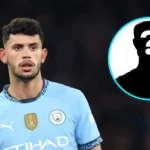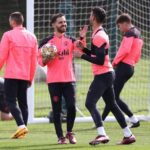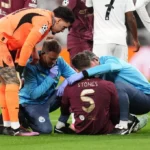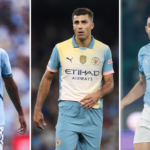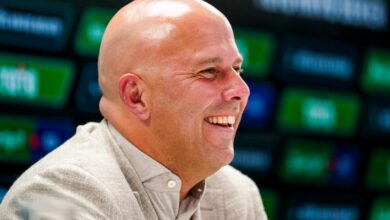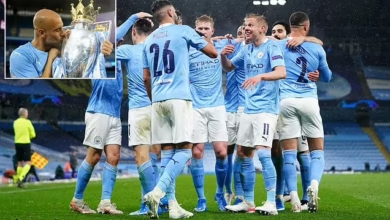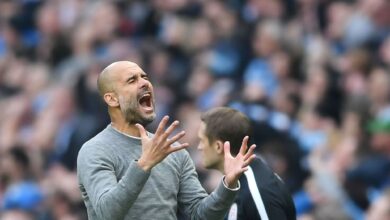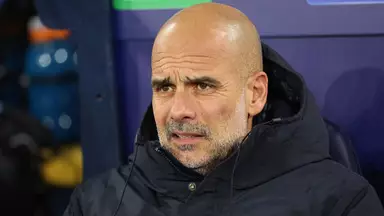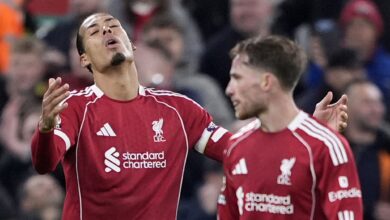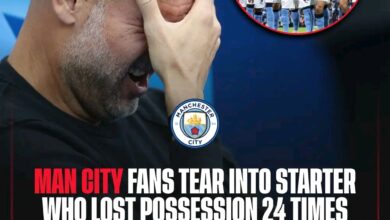Manchester City Comprehensive Injury Report: Rodri, Oscar Bobb, and John Stones – Latest Updates and Return Projections
Manchester City’s 2024-25 campaign has been defined not only by their performances on the pitch but by a series of significant injuries that have hampered Pep Guardiola’s squad throughout what has proven to be a challenging season. The club’s inability to field their strongest XI consistently has played a pivotal role in their disappointing trophy haul, culminating in a heartbreaking 1-0 defeat to Crystal Palace in the FA Cup final at Wembley Stadium.
The absence of key players has been particularly evident in crucial moments, with the FA Cup final serving as a stark reminder of how injuries can derail even the most meticulously planned campaigns. As City prepare for their final two Premier League fixtures against Bournemouth and Fulham, the fitness of several key players remains a talking point that could determine whether the club secures Champions League qualification for next season.
Rodri’s absence has perhaps been the most significant factor in Manchester City’s struggles this season. The Spanish midfielder, who claimed the Ballon d’Or earlier in the campaign, suffered what many feared would be a season-ending anterior cruciate ligament (ACL) injury in the early stages of the 2024-25 season. The timing couldn’t have been worse for Guardiola’s side, as Rodri had established himself as the fulcrum around which City’s tactical system revolved.
The 28-year-old’s injury occurred during what appeared to be a routine challenge, but the severity became apparent immediately as medical staff rushed onto the field. Initial assessments suggested the worst-case scenario, with specialists confirming the ACL tear that would typically sideline a player for eight to ten months. The diagnosis sent shockwaves through the Etihad Stadium and beyond, as City fans realized they would be without their most influential midfielder for the majority of the campaign.
What followed was one of the most remarkable recovery stories in modern football. Rodri’s dedication to his rehabilitation program, combined with cutting-edge medical treatment and the club’s world-class facilities, enabled him to make progress at an unprecedented rate. Working closely with City’s medical team, the midfielder embarked on an intensive recovery program that saw him exceed every projected milestone.
By December, reports emerged that Rodri was ahead of schedule in his recovery, though the club remained cautious about setting unrealistic expectations. The midfielder’s professionalism and unwavering commitment to his fitness regime became the stuff of legend within the training ground, with teammates regularly commenting on his determination to return stronger than before.
The turning point came in late March when Rodri began light ball work, progressing to more intensive training sessions by early April. His return to the training ground sent ripples of excitement through the squad and fanbase alike, with many daring to hope that their talismanic midfielder might feature in the season’s closing stages.
FA Cup Final Disappointment
The FA Cup final presented what many believed could be Rodri’s triumphant return to competitive football. Having traveled with the squad to London and participated in training sessions throughout April, speculation mounted that Guardiola might risk his star player in the showpiece event. The midfielder’s presence around the squad and his visible improvement in training sessions fueled optimism that City’s most important player could make a dramatic comeback.
However, Guardiola’s decision to exclude Rodri from the matchday squad proved to be a crushing blow for City’s hopes. The manager’s cautious approach, while understandable from a medical perspective, left many wondering what might have been had Rodri been available to influence the game. City’s midfield, while competent, lacked the commanding presence and tactical intelligence that Rodri brings to the team.
The defeat to Crystal Palace, courtesy of Eberechi Eze’s first-half strike, felt particularly cruel given how close Rodri had come to returning. The midfielder watched from the stands as his teammates struggled to break down a well-organized Palace defense, his frustration evident as City failed to create clear-cut chances throughout the 90 minutes.
Current Status and Return Prospects
As City enter the final phase of their season, Rodri’s fitness remains the subject of intense speculation. While he has not been cleared for match action, his continued progress in training suggests that a return could be imminent. Guardiola faces a delicate balancing act between wanting to utilize his best player and ensuring that no unnecessary risks are taken with Rodri’s long-term fitness.
The most realistic scenario appears to be a carefully managed return, possibly involving substitute appearances in the remaining fixtures. The away match against Fulham on May 25 presents the most likely opportunity for Rodri to make his long-awaited comeback, particularly if City have secured their Champions League qualification objectives by that point.
Medical staff have emphasized the importance of not rushing Rodri back prematurely, highlighting the need for his knee to be completely stable before he returns to competitive action. The midfielder himself has expressed cautious optimism about his chances of featuring before the season’s end, though he acknowledges that his long-term health must take precedence over short-term goals.
John Stones: The Defensive Dilemma
The Injury Breakdown
England international John Stones has endured perhaps the most frustrating injury of his career, suffering a significant thigh problem during the second leg of City’s Champions League playoff against Real Madrid in February. The injury occurred at a crucial juncture in the season, with City needing defensive stability as they pursued multiple trophies.
The 30-year-old center-back had been enjoying one of his best seasons in a City shirt, forming a formidable partnership at the heart of the defense and contributing significantly to the team’s build-up play. His ability to step into midfield and initiate attacks from deep positions had become an integral part of Guardiola’s tactical setup, making his absence all the more significant.
Initial assessments revealed a complex thigh injury that, while not requiring surgical intervention, would necessitate an extended period of rehabilitation. The nature of the injury meant that Stones would need to rebuild his fitness gradually, with no shortcuts available in the recovery process.
The Silent Struggle
Unlike some high-profile injuries that generate regular updates and media attention, Stones’ rehabilitation has been conducted largely away from the public eye. The club has provided minimal information about his progress, leading to speculation about the severity of his condition and the likelihood of a return this season.
This silence has been interpreted in various ways, with some suggesting that the club is being deliberately cautious about raising expectations, while others fear that the injury has proven more problematic than initially anticipated. The lack of concrete updates has left fans and media alike guessing about Stones’ true condition.
Team sources have indicated that the defender has been working diligently on his recovery, but the complex nature of thigh injuries means that progress has been slower than hoped. The medical team’s conservative approach reflects their determination to ensure that Stones returns fully fit rather than risking a recurrence that could jeopardize his participation in upcoming international tournaments.
Impact on City’s Defense
Stones’ absence has forced Guardiola to reshape his defensive setup significantly. The manager has had to rely more heavily on alternative partnerships, with varying degrees of success. The loss of Stones’ unique skill set – his ability to play out from the back, his aerial prowess, and his leadership qualities – has been keenly felt throughout the campaign.
The defensive instability caused by Stones’ absence has contributed to City’s inconsistent form, with the team looking less assured at the back than in previous seasons. His replacement options, while capable, lack the specific attributes that make Stones so valuable to Guardiola’s system.
Return Outlook
With the season rapidly approaching its conclusion, Stones’ return appears increasingly unlikely. The club’s medical team remains unwilling to provide concrete timelines, suggesting that his rehabilitation is still ongoing. The priority now appears to be ensuring that the England international is fully fit for the start of next season rather than risking a premature return.
The uncertainty surrounding Stones’ condition has implications beyond just the current campaign. With England’s upcoming international fixtures and the defender’s long-term career prospects to consider, the club is likely to err on the side of caution regarding his return to action.
Oscar Bobb: The Young Talent’s Troubled Season
A Season of Setbacks
Norwegian winger Oscar Bobb’s 2024-25 campaign has been a masterclass in frustration, with the young talent enduring a series of injuries that have prevented him from building on his promising breakthrough performances. The 21-year-old’s journey this season reads like a cautionary tale about the physical demands of professional football and the unpredictable nature of injury setbacks.
Bobb’s troubles began shortly after the Community Shield, when what should have been a routine training session resulted in a fractured leg that would sideline him for several months. The injury occurred during a seemingly innocuous challenge, but the impact was severe enough to require immediate medical attention and subsequent surgery.
The timing of the injury was particularly cruel for Bobb, who had impressed during pre-season and was expected to play a more prominent role in Guardiola’s plans for the campaign. His pace, directness, and willingness to take on defenders had marked him out as a player ready to make the step up from promising youngster to regular first-team contributor.
The Long Road Back
Bobb’s recovery from the fractured leg proved to be more complex than initially anticipated. The healing process was slow, requiring multiple assessments and adjustments to his rehabilitation program. The young winger’s frustration was evident as he watched from the sidelines while his teammates battled through a challenging season.
By late March, there were encouraging signs that Bobb was close to a return. He had progressed through various stages of his recovery program and was beginning to participate in more intensive training sessions. The club’s medical team expressed cautious optimism about his prospects of featuring in the season’s final weeks.
The Cruel Twist
Just as Bobb appeared ready to make his comeback, fate dealt him another crushing blow. In late April, during what was meant to be his final rehabilitation session before being cleared for full training, the Norwegian suffered a hamstring injury that set his recovery back significantly.
The hamstring problem was particularly frustrating given how close Bobb had come to returning. The injury occurred during a routine sprint drill, with the winger immediately signaling to medical staff that something was wrong. Initial fears about the severity of the injury were confirmed when scans revealed a significant strain that would require several weeks of treatment.
Current Recovery Status
Despite his recent setback, there are positive signs emerging about Bobb’s condition. The winger has returned to partial team training, working alongside the main squad in limited capacities. His participation in these sessions represents a significant step forward in his recovery, though the club remains cautious about setting firm return dates.
The medical team’s approach to Bobb’s rehabilitation has been notably conservative, reflecting their determination to avoid any further setbacks. The young player’s age works in his favor, as his body should be able to recover more quickly than older players might, but the pattern of injuries has made everyone involved extremely cautious.
Guardiola has spoken positively about Bobb’s attitude throughout his injury troubles, praising the winger’s professionalism and determination to return stronger. The manager has indicated that while Bobb may not feature significantly in the remaining fixtures, his presence around the training ground has been valuable for squad morale.
The Broader Impact on Manchester City’s Season
Tactical Adjustments
The absence of these key players has forced Guardiola to demonstrate his tactical flexibility throughout the season. The manager has had to devise alternative systems and playing styles to compensate for the missing personnel, with varying degrees of success. The lack of Rodri’s presence in midfield has been particularly challenging to address, as few players possess his unique combination of defensive awareness and passing ability.
Guardiola’s attempts to fill the void left by these injuries have involved promoting younger players, adjusting formations, and sometimes deploying players in unfamiliar positions. While this approach has provided valuable experience for squad members who might not otherwise have featured prominently, it has also contributed to the team’s inconsistent performances.
Squad Depth Concerns
The injury crisis has exposed some vulnerabilities in City’s squad depth, particularly in specialized positions. While the club boasts one of the largest and most talented squads in world football, the specific skill sets of players like Rodri and Stones are difficult to replicate. This has highlighted the challenge of building a squad that can maintain its level when key players are unavailable.
The situation has prompted discussions about recruitment strategies and the importance of having adequate cover for crucial positions. City’s experience this season serves as a reminder that even the best-laid plans can be disrupted by unforeseen circumstances.
Financial and Competitive Implications
The inability to field their strongest team consistently has had significant competitive consequences for City. The failure to win any major trophies this season represents a substantial disappointment for a club with such high standards and ambitions. The financial implications of missing out on prize money and potential revenue streams are also considerable.
The uncertainty surrounding Champions League qualification adds another layer of concern, as failure to secure a top-five finish would have far-reaching consequences for the club’s planning and recruitment activities ahead of next season.
Looking Ahead: Recovery Timelines and Season Finale
Remaining Fixtures Strategy
As City prepare for their final two Premier League matches, Guardiola must carefully consider how to utilize any returning players. The temptation to field his strongest available team must be balanced against the risk of aggravating existing injuries or causing new problems that could impact next season’s preparations.
The match against Bournemouth presents an opportunity to assess the fitness of returning players in a competitive environment, while the final day fixture against Fulham could provide a platform for meaningful returns if circumstances permit.
Medical Team’s Approach
City’s medical staff have adopted an notably conservative approach to injury management this season, prioritizing long-term player welfare over short-term competitive gains. This philosophy, while sometimes frustrating for fans and management alike, reflects best practices in sports medicine and the club’s commitment to player welfare.
The medical team’s detailed rehabilitation programs and careful monitoring of player progress have been crucial in managing what could have been an even more devastating injury crisis. Their expertise and patience may prove vital in ensuring that players return fully fit rather than risking further complications.
Next Season Implications
The lessons learned from this injury-ravaged season will undoubtedly influence City’s approach to squad building and injury prevention in future campaigns. The club may look to strengthen their medical department further and invest in additional injury prevention technologies and techniques.
The experience of managing without key players for extended periods has also provided valuable insights into the capabilities of squad members who might not otherwise have featured prominently. This knowledge could prove useful in future team selection and tactical planning.
Conclusion: Resilience in Adversity
Manchester City’s 2024-25 season will be remembered as much for the players who were absent as for those who participated. The injuries to Rodri, John Stones, and Oscar Bobb have created a narrative of what might have been, while also demonstrating the unpredictable nature of professional football.
As the season approaches its conclusion, the focus shifts from what has been lost to what can still be achieved. The potential returns of key players in the final fixtures offer hope for a positive end to a challenging campaign, while the lessons learned from managing extensive injury problems will serve the club well in future seasons.
The true measure of Manchester City’s season may not be found in the trophies they failed to win, but in how they adapted to adversity and maintained their competitive standards despite significant personnel challenges. The character shown by both the remaining players and the club’s management and medical staff throughout this difficult period speaks to the strength of the institution and its ability to overcome setbacks.
Whether Rodri makes his emotional return in the coming weeks, whether Stones can contribute to next season’s ambitions, and whether Oscar Bobb can finally showcase his talents without interruption, remain questions that will define the narrative surrounding Manchester City’s immediate future. What is certain is that the club’s approach to injury management and player welfare during this challenging period has set standards that will influence their operations for years to come.

